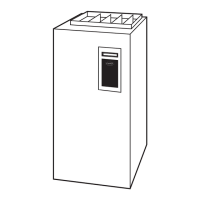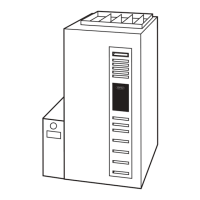10. Remove screws attaching burner box to cell panel. (See Fig.
6.)
NOTE: Burner box cover, manifold, gas valve, and burner
assembly should be removed as 1 assembly.
11. Clean heat exchanger openings with a vacuum and a soft
brush. (See Fig. 7.)
NOTE: After cleaning, inspect the heat exchangers to ensure they
are free of all foreign objects that may restrict flow of combustion
products.
12. Reverse items 4 through 10 for reassembly.
The ground wire from the gas valve MUST be attached to the
burner box attachment screw. Failure to attach this ground
wire to an adequate casing ground will cause the furnace
control to lock out.
NOTE: Be sure burner box gasket is installed between burner box
and cell panel. (See Fig. 6.) If gasket is damaged, replace it.
NOTE: Inspect combustion-air intake housing. If foamed gasket
was removed, check for any damage. If gasket is damaged in any
way, it must be repaired. To repair, remove damaged gasket
section, apply sealant releasing agent such as PAM cooking spray
or equivalent (must not contain corn or canola oil, aromatic or
halogenated hydrocarbons or inadequate seal may occur) to burner
box and apply a small bead of G.E. RTV 162, G.E. RTV 6702, or
Dow-Corning RTV 738 sealant to edge of combustion-air intake
housing. (See Fig. 8.)
13. Refer to furnace wiring diagram and reconnect wires to flame
rollout switch, gas valve, igniter, and flame sensor.
14. Reconnect pressure switch tubes to gas valve and intake
housing. Refer to tube routing label on main furnace door for
proper tube location. (See Fig. 9.) Be sure tubes are not
kinked.
15. Turn on gas and electrical supplies to furnace.
16. Check furnace operation through 2 complete heat operating
cycles. Look through sight glass in burner enclosure to check
burners. Burner flames should be clear blue, almost transpar-
ent. (See Fig. 10.)
17. Check for gas leaks.
FIRE OR EXPLOSION HAZARD
Failure to follow the safety warnings exactly could result in
serious injury, death or property damage.
Never test for gas leaks with an open flame. Use a commer-
cially available soap solution made specifically for the
detection of leaks to check all connections. A fire or explo-
sion may result causing property damage, personal injury or
loss of life.
18. Replace main furnace door.
SECONDARY HEAT EXCHANGERS
NOTE: The condensing side (inside) of the secondary heat
exchangers CANNOT be serviced or inspected. A small number of
bottom outlet openings can be inspected by removing the inducer
assembly. See Flushing Collector Box and Drainage System
section for details on removing inducer assembly.
Step 5—Flushing Collector Box and Drainage
System
1. Turn off gas and electrical supplies to furnace.
2. Remove main furnace door.
3. Disconnect inducer motor and pressure switch wires or
connectors.
4. Disconnect pressure switch tubes.
5. Disconnect vent pipe from inducer housing outlet by loosen-
ing coupling clamp on inducer outlet.
6. Disconnect drain tube from inducer housing. (See Fig. 9.)
7. Remove inducer housing assembly by removing 4 bolts
attaching assembly to cell panel.
8. Flush inside of collector box with water until discharge from
condensate trap is clean and runs freely.
NOTE: Ensure the drain tube disconnected from the inducer
housing is higher than the collector box opening or water will flow
out tube.
9. Inspect inside area of collector box for any pieces of foreign
materials and remove if present.
DO NOT use wire brush or other sharp object to inspect or
dislodge materials in secondary heat exchangers as failure of
the secondary heat exchanger will occur. Flush with water
only.
10. Reassemble inducer assembly by reversing items 5-7. Tighten
the vent coupling clamp screw(s) to 15 in.-lb of torque.
Fig. 7—Cleaning Inlet Openings of Primary Heat
Exchangers
A96305
PRIMARY HX
INLET OPENINGS
Fig. 8—Combustion-Air Intake Housing Gasket
Repair
A93087
PAM
RTV
6
→

